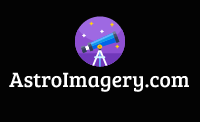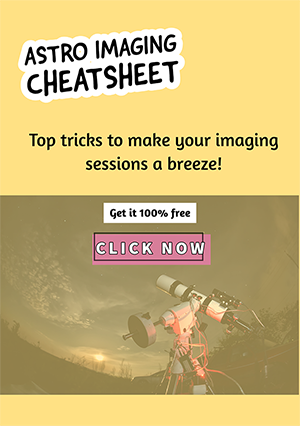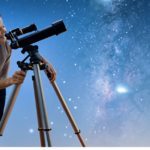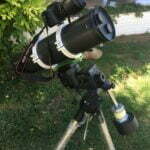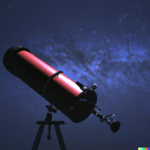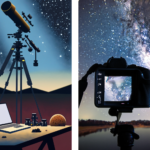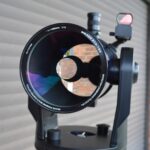Table of Contents
Like many people, I use a DSLR for astrophotography. There are alternatives such as a dedicated electronic astrophotography camera but these are often much more expensive. Most beginners find it easier to start using a DSLR also. In this article, we’ll discover why DSLRs are so popular and which models are the best for astrophotography.
The best DSLR for astrophotography is one that takes high-quality photos with very little noise. Canon or Nikon is very reliable and is very suitable. A model with a live view screen is important for focusing.
Having said that, two of the most reliable and well-known cameras to use for astrophotography are Canon and Nikon, there are many different models both old and new which vary greatly in their usefulness as an astrophotography DSLR. On this page, we will examine in more detail which features and which models are best for you. So let’s get started!
What is the Best DSLR for Astrophotography?
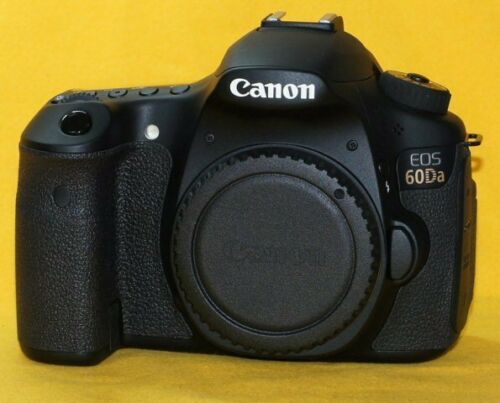
Most people have their own preferences, but actually, the consensus is that you are good to go with any of the three major brands which are Canon, Nikon, and Sony. The general quality seems to be about the same and so you could choose any of these. However, certain models are more suitable for high-quality astrophotography than others.
After 2003, when DSLRs began to be used widely for astrophotography, Canon was the most popular choice. Nikons then had problems that made them a poor choice for the astrophotographer, such as noise reduction that removed some stars. They also lacked a connection for an intervalometer ( a device to automatically take many photos at set intervals and each for a certain length of exposure) and compression was also used on RAW files.
Check out my guide on which is better for astrophotography – Canon or Nikon?
The popularity of Canon led to the creation of a lot of software specifically designed for Canon, for example, Backyard EOS, Astrophotography Tool, etc.
Early Nikons were challenging to use compared to Canon models but this changed as technology progressed. Nikons improved after about 2013, with the introduction of the D5300, which used Sony sensors and had low read noise levels even at higher ISO. This changed the game for Nikon.
Nikon and Canon are both popular choices for astrophotography now, with Sony very much the third choice. This is something for the budding astrophotographer to think about as the most popular choices are probably cheaper in the long run due to more choices of accessories designed for DSLR use in astrophotography.
Both Nikon and Canon have DSLR models with ASP-C and full-frame which has a larger sensor. They both also now sell both mirror and mirrorless versions. Sony has some great cameras like the A6000 or the A7 and these can be used for astrophotography.
So, if you have a preference for one brand your next step in choosing a DSLR would be to look into different models and check which of these are recommended and why. Let’s do exactly that and discover which models might be best for you…
What is needed for DSLR astrophotography?
There are several important aspects of a camera that make it good for astrophotography:
- Noise levels
- Signal-to-noise ratio
- Live view screen
- Sensitivity to light from deep sky objects
- Good resolution
Let’s consider each of the above and how this affects your astrophotos.
Noise Levels
Every camera will produce noise and there are different kinds of noise that affect astrophotographers. There is read noise and thermal noise, for example. In older cameras, such as the one I have, a Canon 600D, noise can be a problem especially when the temperature is higher in summer.
Thermal noise increases as the sensor warms up. As we take longer exposures in deep sky astrophotography, this thermal noise increases as the sensor gets hotter and hotter. I have regularly noticed my camera’s sensor temperature reaching 34C at night on a long imaging session!
Modern cameras have less noise and this doesn’t change with higher ISO levels. My Canon 600D is best at 800 ISO and has more noise at other levels. By taking darks and subtracting them from my individual photos when stacking, much of this noise can be removed but this is not perfect.
A low-noise DSLR is best for astrophotography.
Signal-to-Noise Ratio
The higher the signal compared to the level of noise the better. Imagine a picture of a nebula where the signal is very weak and faint and the details are hidden by lots of noise. This would be a low signal-to-noise ratio (SNR). We can improve the SNR in astrophotography by taking and stacking many shots together and removing noise with Darks and other calibration frames but the better the camera, the better each photo will be and the end result will improve even more.
Consider the SNR when choosing a camera.
Live View Screen
A live view screen is extremely helpful when trying to focus manually on a star or target. I have tried to use a DSLR without a live view screen and it was nearly impossible to do this. The live screen can also help you frame your shot or to move position slightly and enables you to view your photos after they are taken. A live screen definitely makes astrophotography easier!
Sensitivity to Light from Deep Sky Objects
It is important that your DSLR camera can pick up the light from deep sky objects. This is especially true of HA alpha or the red colour of hydrogen gas in nebulae and other deep-sky objects. Normally, filters cut down the available light in this wavelength to simulate how our eyes see, so unless you have a model which is made for astrophotography, (such as the Canon EOS 20Da, 60Da, or the Nikon D810a), you will need to get your camera modified and remove the filter that stops this light.
Resolution
Many people get far too concerned about the differences in the resolution of cameras. In particular, I have addressed a common question that is often asked by those looking for a good camera for astrophotography. The question is: How many megapixels do you need for astrophotography?
A selection of some of the best DSLRs for astrophotography
| Model | Used for | Price Est. |
| Nikon Z6 | Deep Sky Nightscapes | $1198 |
| Nikon Z6 II | Deep Sky Nightscapes | $1749 |
| Canon EOS R6 | Deep Sky Emission Nebulae Nightscapes | $2139 |
| Nikon D810a | Emission nebulae | $1860 |
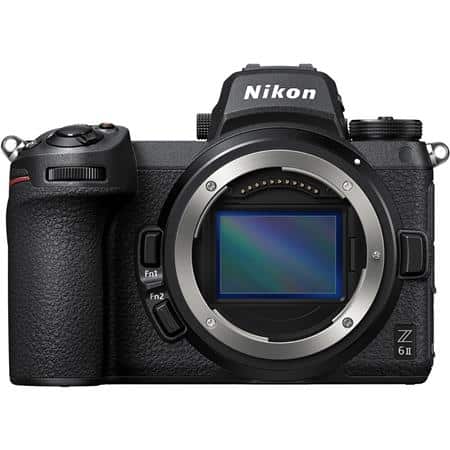
If the above DSLR cameras are a bit above your budget there are many other good choices that cost less. Here is a good place to start:
| Model | Level | Price Est. |
| Canon 600D | Beginner | $650 |
| Nikon 5600 | Beginner | $600 |
| Canon Rebel 450D | Beginner | $200 |
| Canon EOS Rebel T7i | Beginner | $720 |
| Canon EOS 60Da | Beginner | $470 |
The above cameras are just a rough guide and probably the most common choices with the easiest-to-obtain accessories. They all generally satisfy the requirements we have talked about for an astrophotography DSLR.
